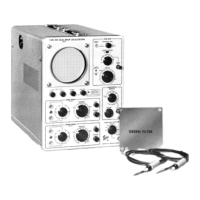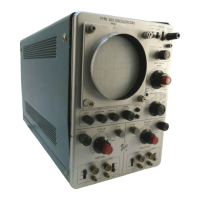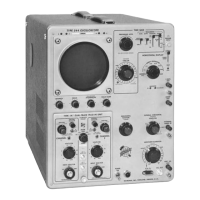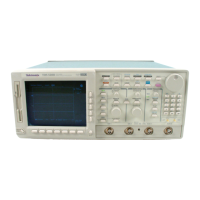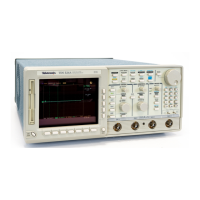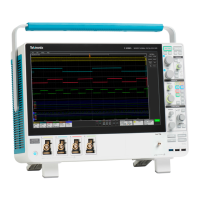System Maintenance—51 03N
4. To replace the
board, reverse the order of
removal.
Use care when replacing pin
connectors; if forced
into place
incorrectly
positioned,
the
pin connectors may be damaged.
Transistor and
Integrated Circuit
Replacement
Transistors and IC's
should
not
be
replaced unless they
are actually
defective. If removed from their
sockets
during
routine maintenance,
return them to
their
original sockets.
Unnecessary replacement
or switching of
semiconductor
devices
may
affect the calibration
of
the instrument.
When
a transistor is replaced,
check
the operation of the part of
the
instrument
that
may
be affected.
POWER switch must be turned off before
removing
or replacing semiconductors.
Replacement semiconductors should be of
the original
type or a direct replacement. Fig.
4-1
shows
the lead
con-
figuration of the semiconductors used in
this instrument
system. When
removing soldered-in
transistors,
use a
suction-type
de-soldering tool
to
remove
the solder from
the holes
in
the circuit board.
An extracting tool
should be used
to remove the
14—
and 16—
pin
integrated circuits
to
prevent damage
to the
pins. This tool
is
available from Tektronix,
Inc. Order Tek-
tronix Part No.
003-0619-00.
If an extracting
tool
is not
available, use care to avoid damaging the
pins. Pull slowly
and
evenly on both ends
of
the 1C.
Try to avoid having one
end of
the 1C disengage
from
the socket before
the other
end.
To replace one of the power transistors mounted
on the
chassis adjacent to the
Power
Supply circuit
board, first
unsolder
the
leads.
Then,
loosen
the nuts on
the plastic bar
that clamps the transistor to the chassis.
Remove
the
defective
transistor. When
replacing
the transistor,
use sili-
cone grease on the metal tab to increase
heat transfer
from
the
transistor to the chassis.
Interconnecting Pin
Replacement
NOTE
A pin
replacement
kit including necessary
tools,
instructions,
and
replacement pins is available from
Tektronix
,
Inc.
Order
Tektronix Part No.
040
-
0542
-
00
.
To replace
a
pin
which
is mounted
on a circuit
board,
first
disconnect
any
pin connectors.
Then, unsolder
the
damaged
pin and pull it out of
the board with
a
pair of
pliers.
Be
careful
not to damage
the wiring
on the board
with
too much heat.
Ream out the
hole in
the circuit board
with
a 0.031-inch drill.
Remove the
ferrule from
the new
interconnecting
pin and
press the new
pin into the hole
in
the
circuit board.
Position the
pin in the
same manner
as
the old
pin. If the old
pin
was
bent
at an angle
to mate
with
a
connector, bend the new
pin to match the
associated pins.
Switch Replacement
The
following
special maintenance
information
is
pro-
vided
for
the cam-type
switches and
pushbutton
switches
used
in
this instrument
system.
Repair of cam-type
switches
should be
undertaken
only
by experienced
maintenance
personnel. Switch
alignment
and
spring tension of
the
contacts must be
carefully
maintained for
proper
operation of
the
switch.
For assistance
in maintenance of
the cam-type
switches,
contact
your local Tektronix
Field Office
or
representative.
A.
CAM-TYPE
SWITCHES
NOTE
A cam-type
switch repair kit
including
necessary
tools,
instructions,
and replacement
contacts is avail-
able from
Tektronix,
Inc. Order
Tektronix
Part No.
040
-
0541
-
00.
The
cam-type
switches
consist
of
rotating
cam
drums
which are turned
by
front-panel
knobs, and
sets
of spring-
leaf contacts
mounted on
adjacent
circuit boards. The
contacts are actuated by lobes
on the cams. In the
5100-
Series
Oscilloscope system, the Volts/Div and
Seconds/Div
switches are of the
cam type. These switches can be dis-
assembled for
inspection, cleaning,
repair, or replacement
as
follows:
1. Remove
the screws
which
hold
the metal cover on
the switch, and
lift the cover off
the
switch.
The
switch
is
now
open for
inspection or cleaning.
2.
To completely remove a
switch
from
the circuit
board,
first remove
any
knobs
or shaft
extensions. Loosen
the
coupling at the
potentiometer at the rear
of the
switch,
and
pull the long shaft (with red knob
attached)
out
of the
switch
assembly.
4-6

